英语句型转换
- 格式:ppt
- 大小:843.50 KB
- 文档页数:27
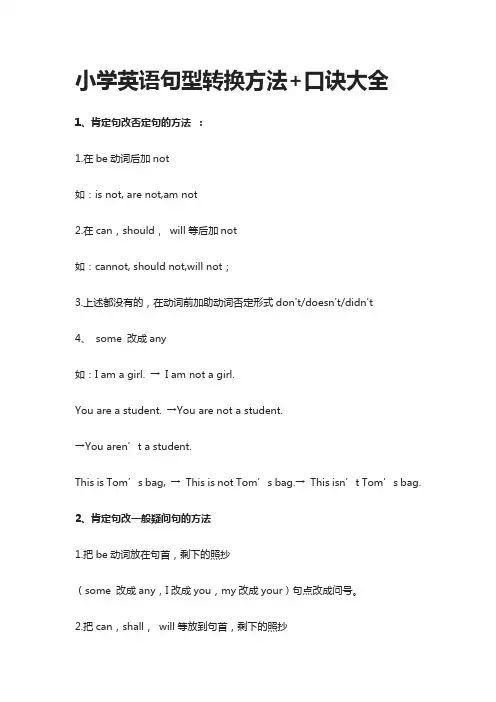
小学英语句型转换方法+口诀大全1、肯定句改否定句的方法:1.在be动词后加not如:is not, are not,am not2.在can,should,will等后加not如:cannot, should not,will not;3.上述都没有的,在动词前加助动词否定形式don't/doesn't/didn't4、some 改成any如:I am a girl. →I am not a girl.You are a student. →You are not a student.→You aren’t a student.This is Tom’s bag, →This is not Tom’s bag.→This isn’t Tom’s bag.2、肯定句改一般疑问句的方法1.把be动词放在句首,剩下的照抄(some 改成any,I改成you,my改成your)句点改成问号。
2.把can,shall,will等放到句首,剩下的照抄(some 改成any,I改成you,my改成your)句点改成问号。
3.上述都没有的,在句首请助动词Do/Does/Did帮忙,剩下的照抄,(some 改成any,I改成you,my改成your,)句点改成问号注意:句首的第一个字母要大写,句尾标点应为“?”如:I am in Class 6. →Are you in Class 6?You are from America.→Are you from America?It is an orange. →Is it an orange?4、就一般疑问句回答一般疑问句有两种回答,即:肯定回答和否定回答。
其中,肯定回答用yes,否定回答用no。
语句顺序为:Yes + 主语+ am /is/ are/was/were.|can.|do/does/did|;No + 主语+ am not/ isn’t/ aren’t 如:—Are you an English teacher?→Yes, I am. /No, I am not.—Is that a bird?→Yes, it is./ No, it isn’t.3、对划线部分提问“就划线部分提问”是小学阶段英语学习的难点,但是一旦掌握了规律,就变得容易多了。
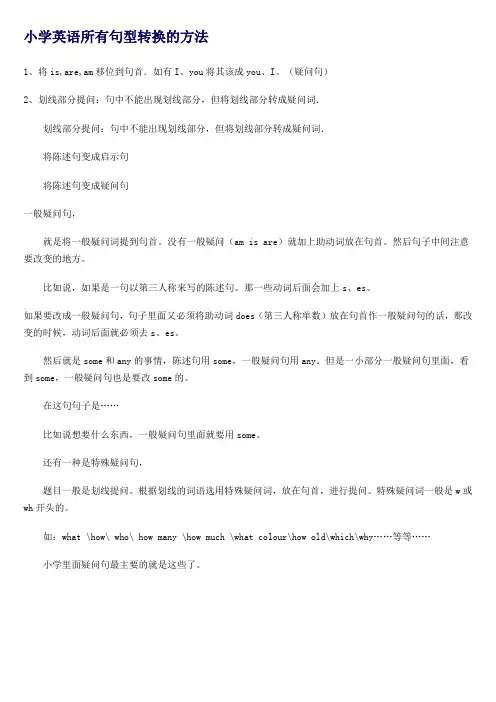
小学英语所有句型转换的方法1、将is,are,am移位到句首.如有I、you将其该成you、I。
(疑问句)2、划线部分提问:句中不能出现划线部分,但将划线部分转成疑问词.划线部分提问:句中不能出现划线部分,但将划线部分转成疑问词.将陈述句变成启示句将陈述句变成疑问句一般疑问句,就是将一般疑问词提到句首。
没有一般疑问(am is are)就加上助动词放在句首。
然后句子中间注意要改变的地方。
比如说,如果是一句以第三人称来写的陈述句。
那一些动词后面会加上s、es。
如果要改成一般疑问句,句子里面又必须将助动词does(第三人称单数)放在句首作一般疑问句的话,那改变的时候,动词后面就必须去s、es。
然后就是some和any的事情,陈述句用some,一般疑问句用any。
但是一小部分一般疑问句里面,看到some,一般疑问句也是要改some的。
在这句句子是……比如说想要什么东西,一般疑问句里面就要用some。
还有一种是特殊疑问句,题目一般是划线提问。
根据划线的词语选用特殊疑问词,放在句首,进行提问。
特殊疑问词一般是w或wh开头的。
如:what \how\ who\ how many \how much \what colour\how old\which\why……等等……小学里面疑问句最主要的就是这些了。
古人云“授人鱼,不如授人渔。
”古人尚且知道授人知识不如授人方法的道理,那么在各种理论高度发展的今天为什么就不能多重视一点方法和传授呢?句子教学是英语教学中的重要环节,有了句子作为基础,学生才能学好英语,也才能真正运用英语。
在几年的英语教学中,我总结了一些英语句子教学的小窍门,现简单归纳如下:一、肯定句改否定句的方法——一步法1、在be动词后加not。
如:is not , are not , am not, was not, were not;2、在can,should, will等后加not。
如:cannot, should not, will not;3、上述都没有的,在动词前加助动词否定形式don’t/doesn’t/didn’t。
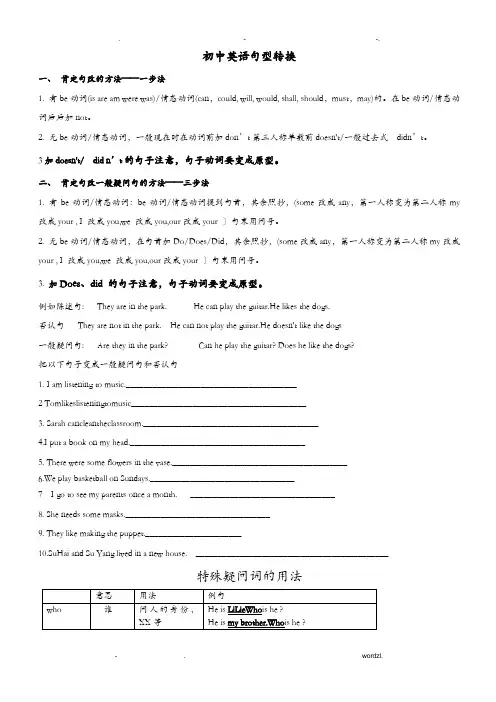
.--.初中英语句型转换一、 肯定句改的方法——一步法 1. 有 be 动词(is are am were was)/情态动词(can,could, will, would, shall, should,must,may)的。
在 be 动词/情态动 词后后加 not。
2. 无 be 动词/情态动词,一般现在时在动词前加 don’t 第三人称单数前 doesn't/一般过去式 didn’t。
3 加 doesn't/ did n’t 的句子注意,句子动词要变成原型。
二、 肯定句改一般疑问句的方法——三步法 1. 有 be 动词/情态动词:be 动词/情态动词提到句首,其余照抄,(some 改成 any,第一人称变为第二人称 my 改成 your , I 改成 you,we 改成 you,our 改成 your 〕句末用问号。
2. 无 be 动词/情态动词,在句首加 Do/Does/Did,其余照抄,(some 改成 any,第一人称变为第二人称 my 改成 your , I 改成 you,we 改成 you,our 改成 your 〕句末用问号。
3. 加 Does、did 的句子注意,句子动词要变成原型。
例如陈述句: They are in the park.He can play the guitar.He likes the dogs.否认句 They are not in the park. He can not play the guitar.He doesn't like the dogs一般疑问句: Are they in the park?Can he play the guitar? Does he like the dogs?把以下句子变成一般疑问句和否认句1. I am listening to music._______________________________________2 Tomlikeslisteningtomusic________________________________________3. Sarah cancleantheclassroom.________________________________________4.I put a book on my head.________________________________________5. There were some flowers in the vase.________________________________________ 6.We play basketball on Sundays._________________________________ 7 I go to see my parents once a month. _________________________________8. She needs some masks._________________________________9. They like making the puppet.______________________10.SuHai and Su Yang lived in a new house. ____________________________________________特殊疑问词的用法意思用法例句who谁问 人 的 身 份 , He is LiLieWhois he ?XX 等He is my brother.Whois he ?-.wordzl..--.whom谁问 人 的 身 份 , I can ask him the question.XX 等(问宾语〕 Whom can you ask the question?what什么问 人 的 职 业 或 He is a worker.What is he?事物是什么He has a book. What does he have ?which哪一个 问一定 X 围内 The big box is mine. Which box is yours?特指的人或物 The girl at the door is Ann. Which girl isAnn?whose谁的问所属关系This is herbook.Whosebook is this ?This book is hers. Whose is this book?what color 什么颜色 问颜色〔表语〕 My skirt is red. What color is your skirt?What time 几点问点时间We play games at five in the afternoon ?What time do you play games?when什么时候 问时间We play games in the afternoon ?When do you play games?where什么地方 问地点〔状语〕 We play games at home on Sunday ?Where do you play games on Sunday?why为什么 问原因He isn't at school today because he is ill.Why isn't he at school today ?how怎样问安康状况、 He is fine/strong. How is he ?做事的方式等 I go home by bike. How do you go home?how old 多大几岁 问年龄He is ten.How old is he ?how many 多少跟复数名词, There are thirtyboys in my class.问数量How manyboys are there in your class?how much 多少跟不可数名词 There is somemilk in the bottle.问数量或价钱 How muchmilk is there in the bottle?how far 多远问路程It's five kilometers away from here?How far is it from here?how soon 多久问 in+一段时间 He can finish it in half an hour.How soon can he finish it ?how long 多久问一段时间, He has lived here for a year.问物体的长短 How long has he lived here?The desk is one meters long.How long is the desk ?how often 多久问频率I go to see my parents once a month.〔一次〕How often do you go to see your parents?How 的疑问句辨析一、how many 和 howmuch 的区别how many 用来询问可数名词的数量,它的句式是:How many+复数名词+一般疑问句+?how much 用来询问不可数名词的数量,也可询问价格。
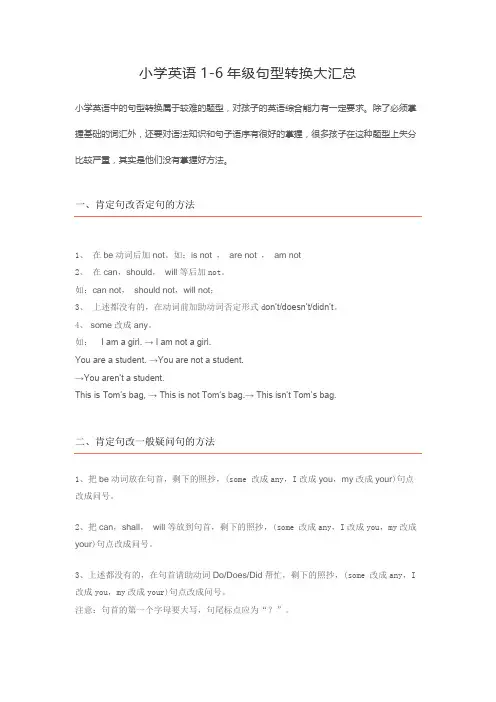
小学英语1-6年级句型转换大汇总小学英语中的句型转换属于较难的题型,对孩子的英语综合能力有一定要求。
除了必须掌握基础的词汇外,还要对语法知识和句子语序有很好的掌握,很多孩子在这种题型上失分比较严重,其实是他们没有掌握好方法。
一、肯定句改否定句的方法1、在be动词后加not。
如:is not ,are not ,am not2、在can,should,will等后加not。
如:can not,should not,will not;3、上述都没有的,在动词前加助动词否定形式d on’t/doesn’t/didn’t。
4、 some改成any。
如:I am a girl. → I am not a girl.You are a student. →You are not a student.→You aren’t a student.This is Tom’s bag, → This is not Tom’s bag.→ This isn’t Tom’s bag.二、肯定句改一般疑问句的方法1、把be动词放在句首,剩下的照抄,(some 改成any,I改成you,my改成your)句点改成问号。
2、把can,shall,will等放到句首,剩下的照抄,(some 改成any,I改成you,my改成your)句点改成问号。
3、上述都没有的,在句首请助动词Do/Does/Did帮忙,剩下的照抄,(some 改成any,I 改成you,my改成your)句点改成问号。
注意:句首的第一个字母要大写,句尾标点应为“?”。
如:I am in Class 6. →Are you in Class 6?You are from America. →Are you from America?It is an orange. →Is it an orange?4、就一般疑问句回答一般疑问句有两种回答,即:肯定回答和否定回答。
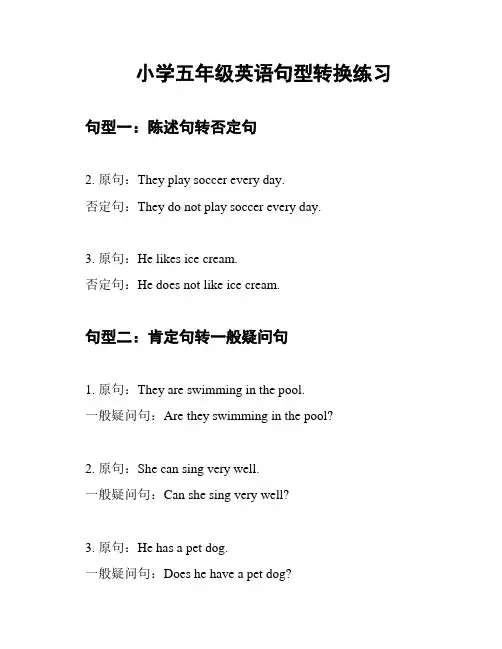
小学五年级英语句型转换练习句型一:陈述句转否定句2. 原句:They play soccer every day.否定句:They do not play soccer every day.3. 原句:He likes ice cream.否定句:He does not like ice cream.句型二:肯定句转一般疑问句1. 原句:They are swimming in the pool.一般疑问句:Are they swimming in the pool?2. 原句:She can sing very well.一般疑问句:Can she sing very well?3. 原句:He has a pet dog.一般疑问句:Does he have a pet dog?句型三:陈述句转选择疑问句1. 原句:They will go to the park or the beach.选择疑问句:Will they go to the park or the beach?2. 原句:She wants to eat pizza or burger.选择疑问句:Does she want to eat pizza or burger?3. 原句:He likes to play basketball or football.选择疑问句:Does he like to play basketball or football? 句型四:一般疑问句转肯定回答和否定回答1. 原问句:Are they going to school?肯定回答:Yes, they are.否定回答:No, they are not.2. 原问句:Can she swim in the river?肯定回答:Yes, she can.否定回答:No, she cannot.3. 原问句:Do you like chocolate ice cream? 肯定回答:Yes, I do.否定回答:No, I do not.句型五:陈述句转感叹句1. 原句:It is a beautiful day.感叹句:What a beautiful day!2. 原句:She is a talented singer.感叹句:What a talented singer she is!3. 原句:He won the first prize.感叹句:What a great achievement he has!。

英语句型转换的方法与例子摘要英语句型转换是指按照一定的要求,把一个句子改写成另一个意思相同或相近的句子,不改变原句的主要意思。
英语句型转换的目的是为了使句子更加简洁、准确、自然和地道,也可以增加句子的变化和丰富性,避免重复和单调。
英语句型转换的方法有很多,本文将介绍以下几种常见的方法:同义词或近义词替换主动语态和被动语态互换陈述句和疑问句互换直接引语和间接引语互换并列句和复合句互换定语从句和非限制性定语从句互换分词短语和独立主格结构互换一、同义词或近义词替换定义同义词或近义词替换是指用意思相同或相近的词或短语来替换原句中的某些词或短语,使句子更加简洁、准确或地道。
规则替换的词或短语必须在意思、用法、搭配和语气上与原词或短语相符。
替换后的句子不能改变原句的主要意思。
替换后的句子不能造成歧义或误解。
例子原句替换后的句子He is very angry with me.He is very mad at me.She passed away last night.She died last night.He made a mistake in the test.He went wrong in the test.I can't stand him.I hate him.He gave me a hand with my homework.He helped me with my homework.二、主动语态和被动语态互换定义主动语态和被动语态互换是指把一个主动语态的句子改写成一个被动语态的句子,或者把一个被动语态的句子改写成一个主动语态的句子,使句子更加客观、强调或适应上下文。
规则主动语态变被动语态时,要把原主语变成by短语放在被动语态谓语之后,把原宾语变成新主语放在被动语态谓语之前,把原谓语动词变成被动形式(即be+过去分词),并保持时态、人称和数一致。
被动语态变主动语态时,要把原by短语去掉,把原主语变成新宾语放在主动谓语之后,把原谓语动词变成主动形式,并保持时态、人称和数一致。
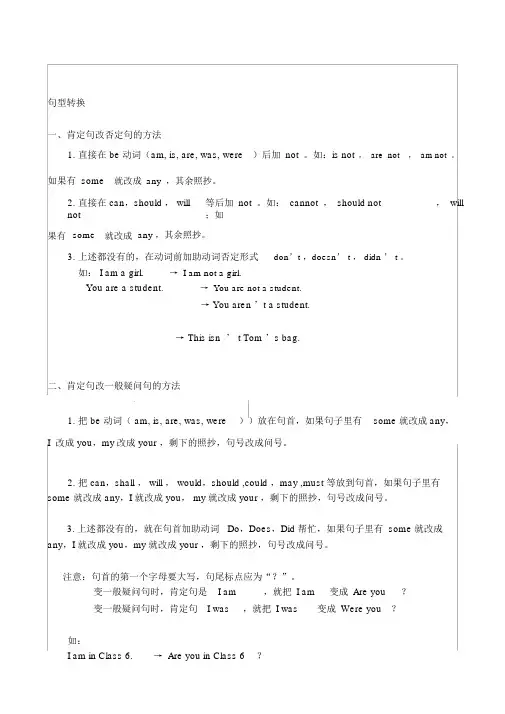
句型转换一、肯定句改否定句的方法1. 直接在 be 动词(am, is, are, was, were)后加not。
如:is not,are not,am not。
如果有 some就改成any,其余照抄。
2. 直接在 can,should , will等后加not。
如:cannot,should not,willnot;如果有some就改成any ,其余照抄。
3. 上述都没有的,在动词前加助动词否定形式don’t ,doesn’ t , didn ’ t 。
如: I am a girl.→ I am not a girl.You are a student.→ You are not a student.→ You aren ’t a student.→This isn ’ t Tom ’s bag.二、肯定句改一般疑问句的方法1. 把 be 动词( am, is, are, was, were))放在句首,如果句子里有some 就改成 any,I改成 you,my改成 your ,剩下的照抄,句号改成问号。
2.把 can,shall , will , would,should ,could ,may ,must 等放到句首,如果句子里有some 就改成 any,I 就改成 you, my就改成 your ,剩下的照抄,句号改成问号。
3.上述都没有的,就在句首加助动词 Do,Does,Did 帮忙,如果句子里有 some 就改成any,I 就改成 you,my就改成 your ,剩下的照抄,句号改成问号。
注意:句首的第一个字母要大写,句尾标点应为“?”。
变一般疑问句时,肯定句是I am,就把I am变成Are you?变一般疑问句时,肯定句I was,就把I was变成Were you?如:I am in Class 6.→ Are you in Class 6?You are from America.→Are you from America ?It is an orange.→ Is it an orange?4. 就一般疑问句回答一般疑问句有两种回答,即:肯定回答和否定回答。
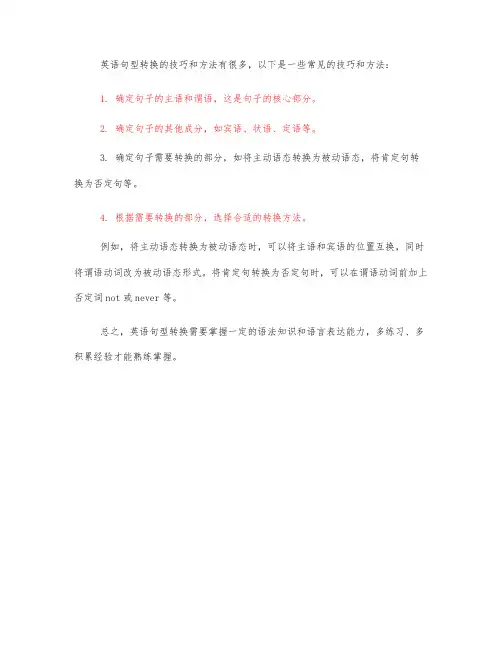
英语句型转换的技巧和方法有很多,以下是一些常见的技巧和方法:
1. 确定句子的主语和谓语,这是句子的核心部分。
2. 确定句子的其他成分,如宾语、状语、定语等。
3. 确定句子需要转换的部分,如将主动语态转换为被动语态,将肯定句转换为否定句等。
4. 根据需要转换的部分,选择合适的转换方法。
例如,将主动语态转换为被动语态时,可以将主语和宾语的位置互换,同时将谓语动词改为被动语态形式。
将肯定句转换为否定句时,可以在谓语动词前加上否定词not或never等。
总之,英语句型转换需要掌握一定的语法知识和语言表达能力,多练习、多积累经验才能熟练掌握。
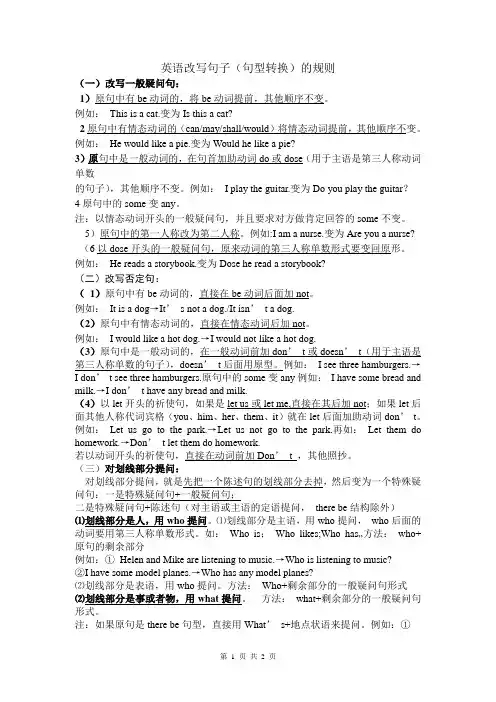
英语改写句子(句型转换)的规则(一)改写一般疑问句:1)原句中有be动词的,将be动词提前,其他顺序不变。
例如:This is a cat.变为Is this a cat?2原句中有情态动词的(can/may/shall/would)将情态动词提前,其他顺序不变。
例如:He would like a pie.变为Would he like a pie?3)原句中是一般动词的,在句首加助动词do或dose(用于主语是第三人称动词单数的句子),其他顺序不变。
例如:I play the guitar.变为Do you play the guitar?4原句中的some变any。
注:以情态动词开头的一般疑问句,并且要求对方做肯定回答的some不变。
5)原句中的第一人称改为第二人称。
例如:I am a nurse.变为Are you a nurse? (6以dose开头的一般疑问句,原来动词的第三人称单数形式要变回原形。
例如:He reads a storybook.变为Dose he read a storybook?(二)改写否定句:(1)原句中有be动词的,直接在be动词后面加not。
例如:It is a dog→It’s not a dog./It isn’t a dog.(2)原句中有情态动词的,直接在情态动词后加not。
例如:I would like a hot dog.→I would not like a hot dog.(3)原句中是一般动词的,在一般动词前加don’t或doesn’t(用于主语是第三人称单数的句子),doesn’t后面用原型。
例如:I see three hamburgers.→I don’t see three hamburgers.原句中的some变any例如:I have some bread and milk.→I don’t have any bread and milk.(4)以let开头的祈使句,如果是let us或let me,直接在其后加not;如果let后面其他人称代词宾格(you、him、her、them、it)就在let后面加助动词don’t。
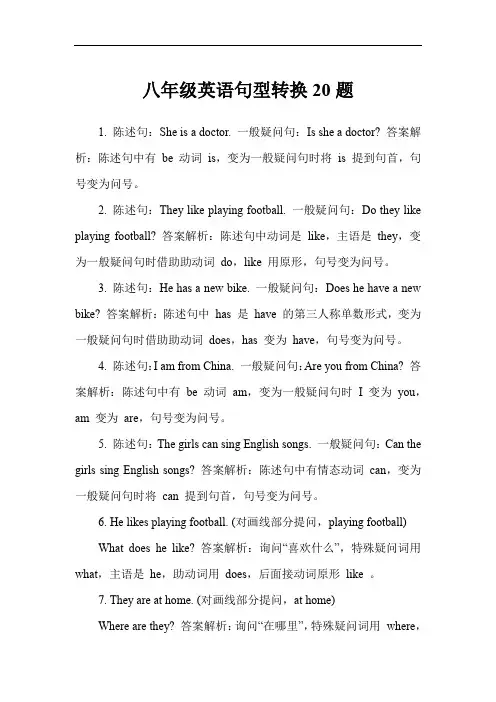
八年级英语句型转换20题1. 陈述句:She is a doctor. 一般疑问句:Is she a doctor? 答案解析:陈述句中有be 动词is,变为一般疑问句时将is 提到句首,句号变为问号。
2. 陈述句:They like playing football. 一般疑问句:Do they like playing football? 答案解析:陈述句中动词是like,主语是they,变为一般疑问句时借助助动词do,like 用原形,句号变为问号。
3. 陈述句:He has a new bike. 一般疑问句:Does he have a new bike? 答案解析:陈述句中has 是have 的第三人称单数形式,变为一般疑问句时借助助动词does,has 变为have,句号变为问号。
4. 陈述句:I am from China. 一般疑问句:Are you from China? 答案解析:陈述句中有be 动词am,变为一般疑问句时I 变为you,am 变为are,句号变为问号。
5. 陈述句:The girls can sing English songs. 一般疑问句:Can the girls sing English songs? 答案解析:陈述句中有情态动词can,变为一般疑问句时将can 提到句首,句号变为问号。
6. He likes playing football. (对画线部分提问,playing football)What does he like? 答案解析:询问“喜欢什么”,特殊疑问词用what,主语是he,助动词用does,后面接动词原形like 。
7. They are at home. (对画线部分提问,at home)Where are they? 答案解析:询问“在哪里”,特殊疑问词用where,主语是they,be 动词用are 。
8. She goes to school by bike. (对画线部分提问,by bike)How does she go to school? 答案解析:询问“出行方式”,特殊疑问词用how,主语是she,助动词用does,后面接动词原形go 。
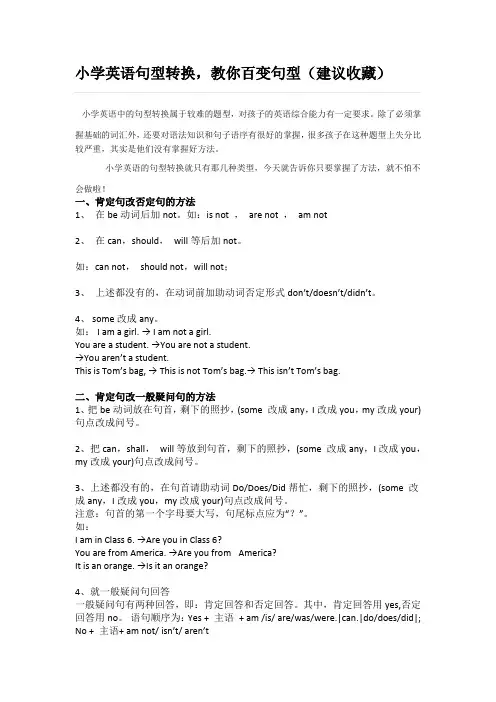
小学英语句型转换,教你百变句型(建议收藏)小学英语中的句型转换属于较难的题型,对孩子的英语综合能力有一定要求。
除了必须掌握基础的词汇外,还要对语法知识和句子语序有很好的掌握,很多孩子在这种题型上失分比较严重,其实是他们没有掌握好方法。
小学英语的句型转换就只有那几种类型,今天就告诉你只要掌握了方法,就不怕不会做啦!一、肯定句改否定句的方法1、在be动词后加not。
如:is not ,are not ,am not2、在can,should,will等后加not。
如:can not,should not,will not;3、上述都没有的,在动词前加助动词否定形式don’t/doesn’t/didn’t。
4、 some 改成any。
如:I am a girl. → I am not a girl.You are a student. →You are not a student.→You aren’t a student.This is Tom’s bag, → This is not Tom’s bag.→ This isn’t Tom’s ba g.二、肯定句改一般疑问句的方法1、把be动词放在句首,剩下的照抄,(some 改成any,I改成you,my改成your)句点改成问号。
2、把can,shall,will等放到句首,剩下的照抄,(some 改成any,I改成you,my改成your)句点改成问号。
3、上述都没有的,在句首请助动词Do/Does/Did帮忙,剩下的照抄,(some 改成any,I改成you,my改成your)句点改成问号。
注意:句首的第一个字母要大写,句尾标点应为“?”。
如:I am in Class 6. →Are you in Class 6?You are from America. →Are you from America?It is an orange. →Is it an orange?4、就一般疑问句回答一般疑问句有两种回答,即:肯定回答和否定回答。
--初中英语句型转换一、 肯定句改的方法——一步法1. 有 be动词(is are am were was)/情态动词(can,could, will, would, shall, should,must,may)的。
在 be 动词/情态动词后后加not。
2. 无be 动词/情态动词,一般现在时在动词前加 don’t 第三人称单数前 doesn't/一般过去式 didn’t。
3 加 doesn't/ did n’t 的句子注意,句子动词要变成原型。
二、 肯定句改一般疑问句的方法——三步法1. 有 be 动词/情态动词:be 动词/情态动词提到句首,其余照抄,(some 改成any,第一人称变为第二人称my改成 your , I 改成 you,we 改成 you,our 改成 your )句末用问号。
2. 无be动词/情态动词,在句首加 Do/Does/Did,其余照抄,(some 改成any,第一人称变为第二人称my 改成your , I 改成you,we 改成 you,our 改成 your )句末用问号。
3. 加 Does、did 的句子注意,句子动词要变成原型。
例如 陈述句: They are in the park.He can play the guitar.He likesthe dogs.否定句 They are not in the park. He can not play the guitar.Hedoesn't like the dogs一般疑问句: Are they in the park?Can he play the guitar?D o eshe like the dogs?把下列句子变成一般疑问句和 否定句1. I am listening to music. _______________________________________ ﻩ ﻩ2 Tom likes listening to music________________________________________3. Sarah can clean the classroom. _ ____ _ __ _ ______ _ _ _ _ _ _ _______ _ __ _ _ _ ﻩ______4. I put a book on my head. ﻩ______ _ _ _ _ _ _ ____________ _ ___ _ ______ _ ____5. There were some flowers in the vase. ___________________________________ﻩ_____ 6. We play basketball on Sundays. ______ 7 I go to see my parents once a month.___________________________ﻩ _______________________________----__8. She needs some masks._________________________________ﻩﻩﻩﻩﻩ9. They like making the puppet.ﻩﻩ______________________10.SuHai and Su Yang lived in a new house.________________________ﻩ____________________特殊疑问词的用法who whom what whichwhosewha t color What t i me when wherewhy意思 谁 谁什么 哪一个谁的什么颜色 几点 什么时候 什么地方为什么用法 问人的身份,姓 名等 问人的身份,姓 名等(问宾语) 问人的职业或 事物是什么 问一定范围内 特指的人或物问所属关系问颜色(表语) 问点时间问时间问地点(状语)问原因例句He is LiLieWho is he ?H e is m y b r o ther.Who ishe ?I can ask him the question.Whom can you ask the question?He is a worker.What is he?He has a book. What doeshe have ?The big box is mine. Whichbox is yours?The girl at the door is Ann.Which girl is Ann?This is her book. Whose book is this ?This book is hers. Whose is thisbook?My skirt is red. What color isyour skirt?We play games at five in the afternoon ?What time do you play games?W e pl a y gam e s i n the afternoon ?When do you play games?We play games at home on Sunday ?Where do you play games onSunday?He isn't at school today because he is ill.Why isn't he at school today ?--how怎样--问健康状况、 He is fine/strong.How is h做事的方式等 e ?I go home by bike. How do yougo home?how old 多大几岁 问年龄He is ten.How old is he ?how ma 多少跟复数名词,There are thirty boys in myny问数量class.How many boys are there in yourclass?h ow 多少跟不可数名词 There is some milk in the bottle.much问数量或价钱 How much milk is there in the bottle?h o w fa 多远问路程It's f ive ki lometers aw ay frrom here?How far is it from here?how soo 多久问 in+一段时间 He can finish it in half an hounr.How soon can he finish it ?h o w l 多久问一段时间,He has lived here for aong问物体的长短 year.How long has he lived here?The desk is one meters long.How long is the desk ?h o w 多久问频率I go to see my parents once aoften(一次)month.How often do you go to see your parents?How 的疑问句辨析一、how many 和how much 的区别how many 用来询问可数名词的数量,它的句式是:How many+复数名词+一般疑问句+?how much 用来询问不可数名词的数量,也可询问价格。
三年级英语句型转换方法归纳三年级英语句型转换方法主要包括以下几种:1. 肯定句改否定句的方法:在be动词后加not,没有be动词则加助动词。
肯定句中有some,否定句中将其改为any。
肯定句中有and,否定句中用or替换。
2. 陈述句变一般疑问句的方法:将be动词/助动词提前,首字母大写。
疑问词+be动词/助动词+主语+其他?3. 陈述句变特殊疑问句的方法:先找出be动词或助动词,将其提前,再确定疑问词。
疑问词+be动词/助动词+主语+其他?4. “have”变“there be”结构:there be表示“存在”,have表示“拥有”。
there be +名词+地点,表示某地有某物。
5. 时态的转换:现在进行时:be+动词ing形式,表示正在进行的动作。
一般现在时:动词原形或第三人称单数形式,表示经常发生的动作或存在的状态。
一般过去时:动词过去式,表示过去发生的动作或存在的状态。
6. 人称代词的转换:主格:I(我)、you(你)、he(他)、she(她)、it(它)、we(我们)、you(你们)、they(他们)。
宾格:me(我)、you(你)、him(他)、her(她)、it(它)、us (我们)、you(你们)、them(他们)。
7. 地点介词的转换:in表示在某一范围内或在某物的里面。
on表示与某物接触或在某物的上方。
under表示在某物的下方。
near表示在某物的附近。
next to表示紧挨着某物。
8. 常用短语和表达的转换:Good morning!早上好!Good afternoon!下午好!Good night!晚安!9. 形容词和副词的比较级和最高级的转换:比较级在形容词后加-er,最高级在形容词后加-est。
一些特殊形式的比较级和最高级,如well(更好地),better(最好的),best(最好的)。
10. 特殊疑问词的转换:what什么,对物品的名称进行提问。
where哪里,对地点进行提问。
初一英语语法--句型转换(详细内容)初一英语语法—句型转换内容:陈述句:肯定句否定句疑问句:一般疑问句特殊疑问句一.肯定句变否定句1.句子中有be,在be后加not。
(be动词有am , is , are, was, were)1)I am a student. I am not a student.2)They are blue . They aren’t blue.3) He is Kangkang. He is n’t Kangkang .4) I was ten last year. I wasn't ten yesterday.5) He was good at English. He wasn't good at English.6) They were at home last Sunday. They weren't at home last Sunday.练习:把下列句子变为否定句1.His father is an English teacher._____________________________2.He is crying under the tree. ___________________________ __3.He was thirteen years old two years ago._______________________4.They are very lucky.______________________________________5.t the family was poor.6.My voice was too weak.2.谓语是动词原形,在动词前加don’t。
7.I have a book . I don’t have a book.8.They like Chinese . They don’t like Chinese.9.3) We come from China. We don’t come from China.3.谓语动词是第三人称单数,在动词前加doesn’t,动词用原形。
英语句型转换(⼀般⼀问句转特殊疑问句)★必备知识点:1.be动词:am、is、 are、 was、 were;⼩学阶段,be动词后只接名词,形容词或动词的ing形式。
2.助动词:do、does、did、 have、 had;助动词后的动词⽤原形。
3.情态动词can、must、will、may、need等;情态动词+动词原形⼀、肯定句、否定句定义1.肯定句:表⽰肯定的意思, 即不含有否定词“不”。
例:我是⼀个学⽣ I am a student. 他去上学 He goes to school.2.否定句:表⽰否定的意思。
例:我不是⼀个男孩。
I am not a boy 他不去上学 He does not go to school.⼆、⼀般疑问句(⼀)、什么是⼀般疑问句⽤Yes或No作答的疑问句叫⼀般疑问句。
⼀般疑问句还有下列特点:1、以be动词、助动词或情态动词开头;例:Is your father a teacher? Does Catherine like animals?Can Jenny speak French?2、往往读升调;3、译成汉语,都可以带上“吗”,例如上⾯三句可分别译为:你⽗亲是⽼师吗?凯瑟琳喜欢动物吗?詹妮会说法语吗?★(⼆)、如何将陈述句变成⼀般疑问句?要将陈述句变成⼀般疑问句,可以遵循下列步骤:1.看句中有没有be动词(am、is、 are、 was、 were)、助动词(do、does、did、 have、 had)或情态动词(can、must、will、may等),如果有,将其提到句⾸,句末打上问号即可。
例:It was rainy yesterday. →Was it rainy yesterday?T om's father can play the piano. →Can Tom's father play the piano?I have finished my homework.→Have you finished your homework?2.如果句中没有be动词、助动词或情态动词,则根据谓语动词的形式借助do的相应形式放在句⾸。